Return Journey
I was awake early again on the Monday morning, after my rather haphazard exploration the day before (see …And Also The Trees.) When I looked out, a good number of the other tents had gone, and my own looked rather sad and lonely in the field. I gathered a few things together and walked down to the farmhouse for a nice hot shower. There were a couple of children playing in the next field, and there were signs of life in a caravan parked next to the fence. The chickens were roaming around in the yard, and I muttered a quiet curse towards the cockerel, who had woken me for the second day running.
I emerged from the shower room refreshed and ready to face the world. It was only about eight o'clock. I decided to hit the road early and aim for the 0925 bus to Monmouth. Even though I wasn't in a great hurry to get back to Aberdare, I could feel the usual post-trip-away-comedown coming on.
I wasn't looking forward to the next job of the day – dismantling the bloody tent. It was still damp from the night before, and I knew that just trying to fold it would be a hard task. Putting it back in its little sack would be a nightmare. I decided to leave the tent until last, and packed the rest of my stuff away. I took my bits of rubbish down to the recycling bins near the site entrance, and then braced myself to tackle the tent.
As I'd found when I was putting it up, it would ideally have been a two-man job. The poles came apart inside the little pockets they slide through, and I had a hell of a job forcing them out. After about five minutes, I extricated the last of the poles and put them in their bag. The tent was down, and I spread it flat on the grass. It seemed to be at least three times longer than the sack was wide, and I couldn't see any natural folds which would have given me a guide.
I eventually stuffed it into the sack and – as I'd expected – the zip wouldn't close. I managed to close it loosely with a bit of nylon thread I found on a fence. I took a last look around to make sure I had everything and made my way back towards the farmhouse.
Mrs Lander and her granddaughter were outside when I arrived in the farmyard. I thanked her for her hospitality, and promised that I'd spread the word about the site. After all, at only £6 per person per night, and with the facilities that it offered, Rushmere Farm had been a real find. I told her that if I decided to explore the area in more detail in the future, I'd be there like a shot. Then I said 'goodbye' and walked down the driveway to the main road.
I arrived in Coleford at about quarter to nine. The sun was shining again, and I wondered if there was anywhere to have a hot drink before the bus arrived. I'd spotted a café in the side street by the cashpoint the night before. I decided to check it out. There was a sign on the door advising customers that they'd decided to close about a month or so before. I knew there was another café near the Market Cross, so I walked across the square to have a look. It didn't open until ten o'clock. I called into the Tesco Express and bought a couple of cereal bars for breakfast. So far, so feeble…
It crossed my mind that there was a 'railway museum' in the town – I'd seen the signpost for it when I got off the bus the previous evening – so I followed the sign and it led me to a pleasant pedestrianised square behind the Co-op. The museum turned out to be Coleford's old station, with a couple of pieces of rolling stock. It's obviously privately owned, as there was a contact phone number on the sign near the main entrance. Needless to say, at that time of the morning there was no sign of life.
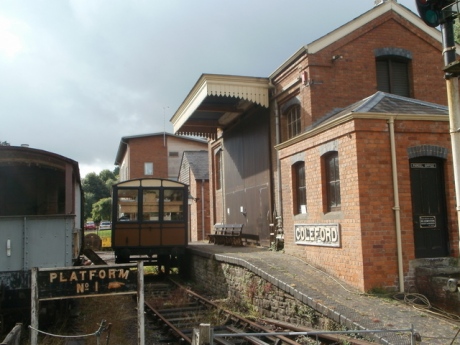
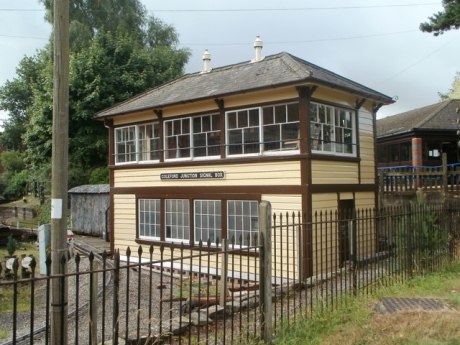
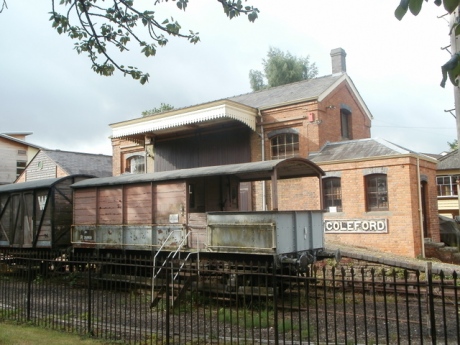
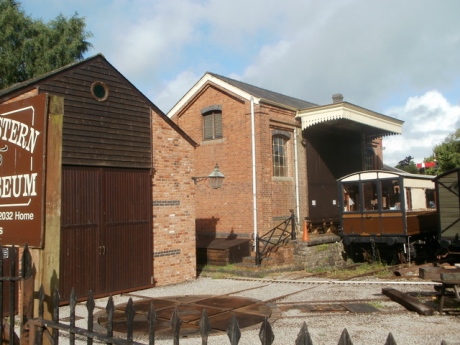
It's a pity that the old High Level Station in Aberdare hasn't been preserved like this, instead of being left to fall into disrepair. Billy's father's collection of railway memorabilia would have found the perfect home in somewhere like this.
A short distance from the Railway Museum I found Coleford's council offices and library under one roof. The library seems to open for about four hours a day, and I didn't want to hang around until eleven just to check out old OS maps and local history books. I strolled over as far as the Tourist Information Centre, only to find that it didn't open until ten o'clock. I made my way back to the town square, and decided to have a nose in the small bookshop I'd spotted the previous day. It was bigger than it looked from the outside, quite well-stocked, and had a good range of local history books. All of them were fairly expensive, though. I only wanted a small leaflet to keep as a souvenir, and a postcard to give to Rhian. I didn't especially want to spend a tenner on a book of photos, even though it was very tempting.
I went back to the square and before long the bus to Monmouth arrived. I took a seat near the back and relaxed to enjoy the journey into Wales. By my reckoning, I'd be able to connect straight onto the Abergavenny bus at Monmouth. For the second time I was glad that I'd resisted the temptation to walk for what (on the map, anyway) seemed like a relatively short journey. The bus went uphill and down dale on a narrow winding road with no pavements. In the meantime, heavy lorries were making their way into the Forest to deliver to shops and businesses. I could have been seriously injured, or even killed, if I'd tried to do the journey on foot.
My plan to get the connection was completely scuppered when we arrived at Monmouth. A van had a puncture, and the driver had parked in the middle of the road to change the wheel. It couldn't be helped, but the traffic was tailing back in both directions. By the time we negotiated Monmouth's narrow streets, the Abergavenny bus had gone.
Undaunted, I decided to make the most of the sunshine and have a look around the town. Apart from the very brief stopover on Saturday, I hadn't been there for years. Mother and I used to go there regularly years ago, for a change of scene from Brecon. I remember one time we bumped into Tom Evans in a car park. Tom used to teach Geography in my school (although he never taught me), and he was a mainstay of the Cynon Valley History Society. We knew each other by sight, and I think we were both startled to meet up in the middle of Monmouth on a Saturday afternoon.
I walked through the busy main street as far as the Shire Hall.
[caption id="attachment_8563" align="aligncenter" width="460"]
 The Shire Hall, Monmouth[/caption]
The Shire Hall, Monmouth[/caption]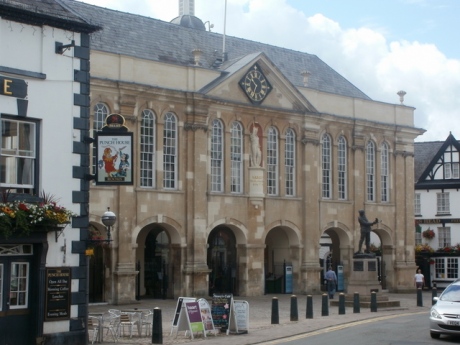
There are a couple of interesting statues commemorating sons of Monmouth outside the Shire Hall:
[caption id="attachment_8565" align="aligncenter" width="460"]
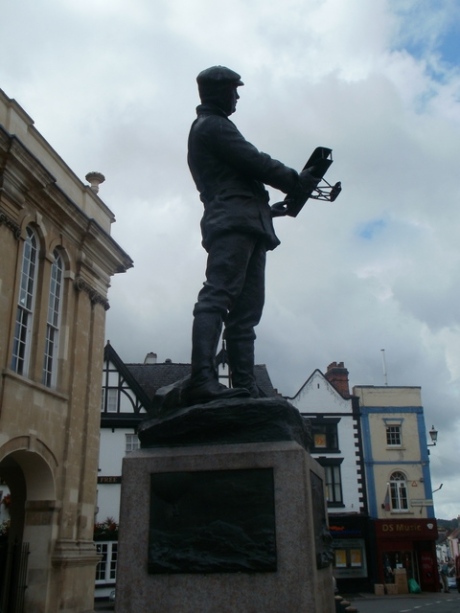 Charles Stewart Rolls (1877-1910)[/caption]
Charles Stewart Rolls (1877-1910)[/caption]The co-founder of Rolls-Royce was the son of the 1st Baron Llangattock; even though he was born in London, he grew up at The Hendre, a few miles from Monmouth.
[caption id="attachment_8566" align="aligncenter" width="460"]
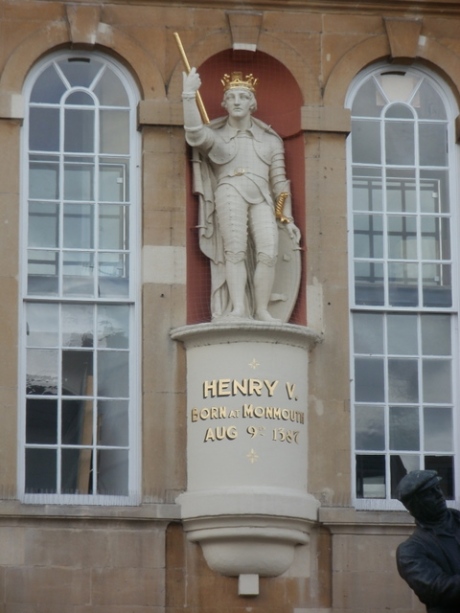 Henry V (1386-1422)[/caption]
Henry V (1386-1422)[/caption](In a side street, I came across a hair salon which was offering discounts to anyone who was willing to have their hair cut by a student. I was tempted, but then I wondered whether I'd have to have a Henry V cut, and decided against it.)
[caption id="attachment_8567" align="aligncenter" width="220"]
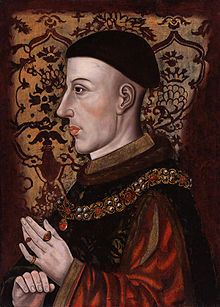 Not a good look![/caption]
Not a good look![/caption]Just opposite the Shire Hall, I spotted an independent bookshop that was in the process of closing down. I called in to see what they had in the way of postcards and local interest books. I was the only customer in there, and I chatted to the middle-aged lady behind the counter for a few minutes. I told her that I could sympathise with her predicament; after all, I can remember a time (not too long ago) when Cardiff city centre boasted Lear's, Lear's Children's Books, Lear's Bargain Books, Lear's University Bookshop, Dillons, Waterstone's, Claude Gill, Chapter and Verse, W.H. Smith and John Menzies. Now, that list has been reduced to just three – and the survivors are struggling.
By some weird twist of fate, I spotted a small book on a table. It was called The Bookshop Strikes Back, by Ann Patchett. It's an inspiring story of an American writer who realised that her city no longer had a bookshop, and resolved to do something about it by opening one herself. It was priced at £1.99, so I decided to buy it (more out of a sense of guilt than anything else.) The lady charged me £1.20. Everything was selling at 40% off the marked price, just to clear the shelves.

Just across the road, in a side street running down from the Shire Hall, there were two other small bookshops side-by-side. One of them looked quite modern and very well-connected, with a large list of author events and signings displayed on a board in the window. The other seemed to be more of a traditional independent bookshop, haphazardly-stocked and far more interesting. I followed my instincts and bought Rhian's postcard in the second one.
[A digression: Out of curiosity, I've just Googled the name of the former shop. As I'd suspected, it's owned by the last manager I worked under when I was in Waterstone's. I knew the name rang a bell with me when I was passing the window. After the way he treated us all when he was running our shop, I wouldn't piss on his shop if it was on fire.]
I had a little wander down the back streets. In the same cobbled lane as the side-by-side bookshops, I stumbled upon the Savoy Theatre. I don't know how big it is inside, but I don't imagine it's as big as the Coliseum in Trecynon.
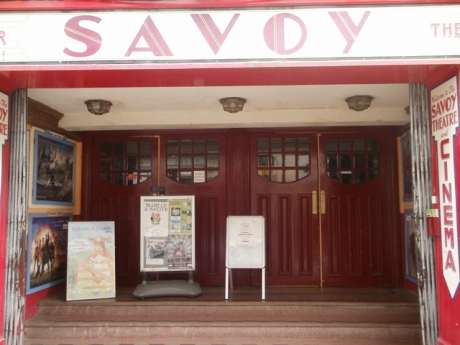
I emerged from the other end of the land and found that I'd made my way to the old Priory Church, which dominates one end of the town with its mighty spire.
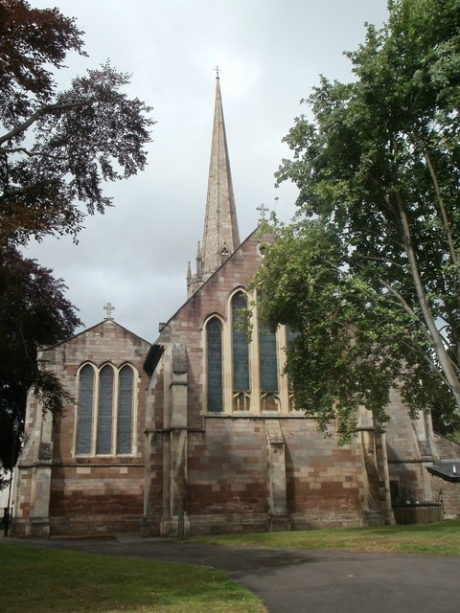
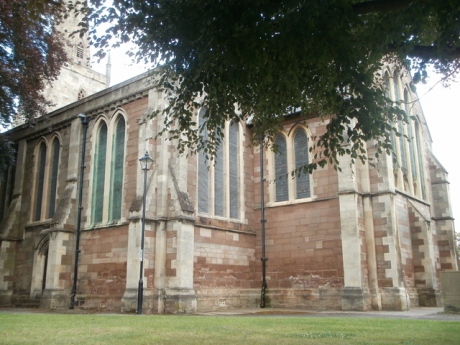
Not far from the church, I found my way to the library. I didn't go in, because I knew I'd get lost in old maps and archives if I did. Like the church (and many of the other buildings in the town), it's built of red sandstone. That rusty-brown hue is the main colour of the buildings in the town. A short distance away, there's a little green space which is home to the town's war memorial.
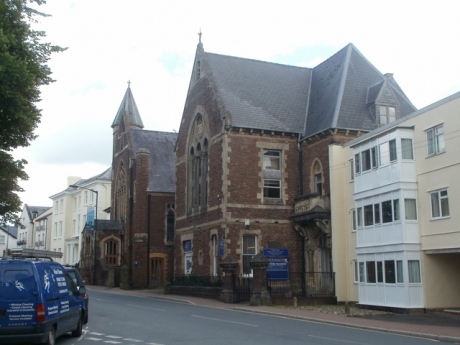
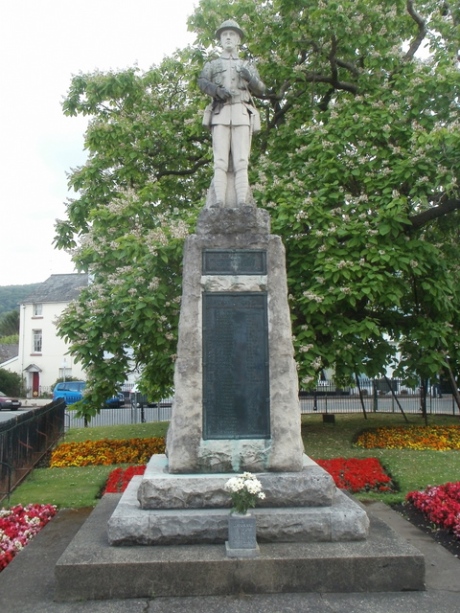
Not far from here I found a small pub called The Griffin, tucked away on a corner. Some years ago, Pam, Gaz and I discovered a pub in the back streets of Monmouth, which reminded us of The Carpenters – it had a decent jukebox, live music, and a fairly rock/biker/hippy customer base. This pub hosts live music and looks as though it might have been the same place.
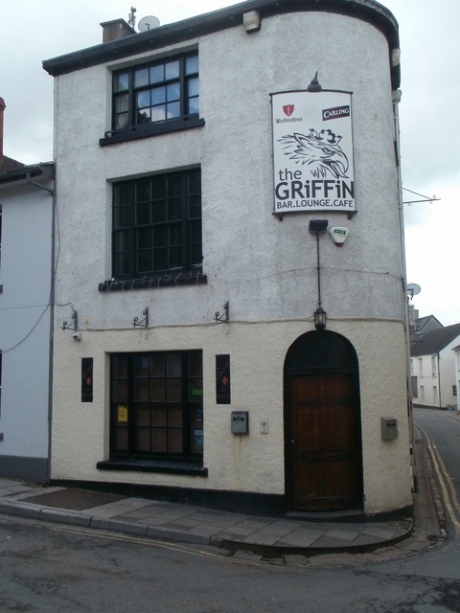
Then again, it could have been The Queen's Head, which is also tucked away on the corner of some side streets…

Or, possibly, it could have been The Old Nag's Head…
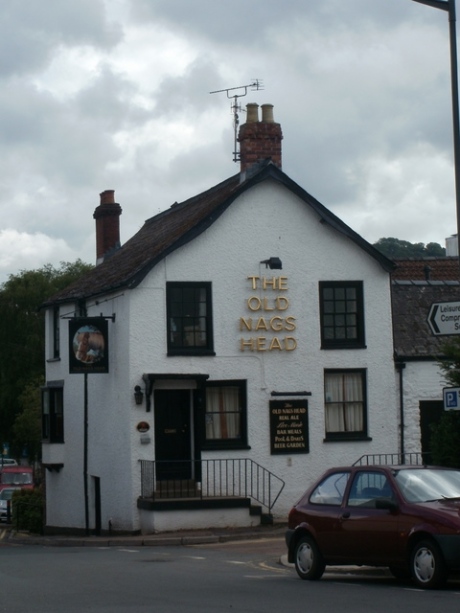
Anyway, none of them were open, so I'll probably never be sure.
There were some more interesting buildings tucked away near the church, including two chapels which couldn't have been more different in style:
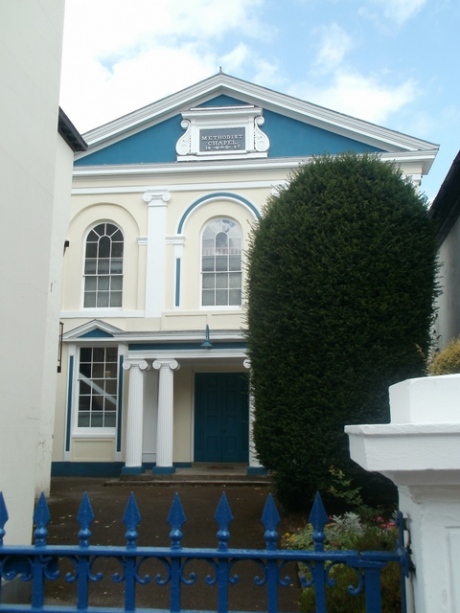
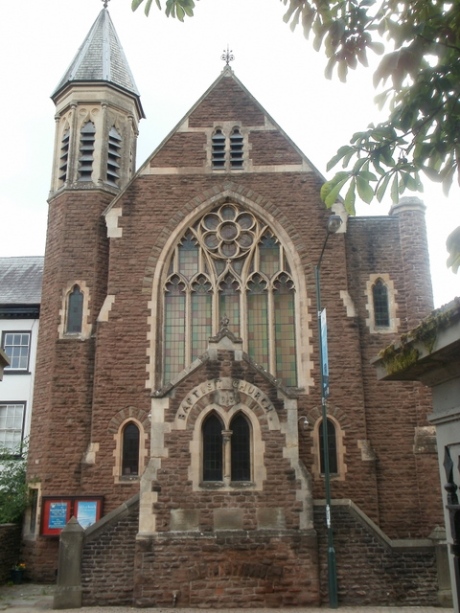
There's one massive building, of course, which you can't help seeing wherever you are at the top end of the town – Monmouth School:
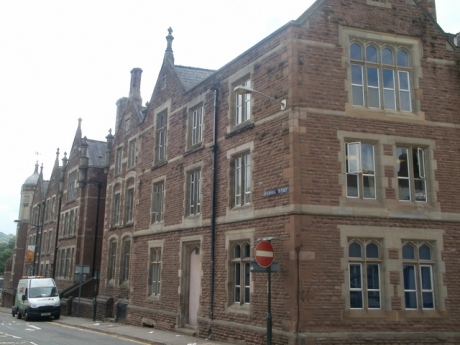
I haven't had chance to look at the Buildings of Wales guide to the county, so I don't know anything about the history of the school, but it's an impressive view as you enter Wales from the Forest of Dean:
[caption id="attachment_8579" align="aligncenter" width="460"]
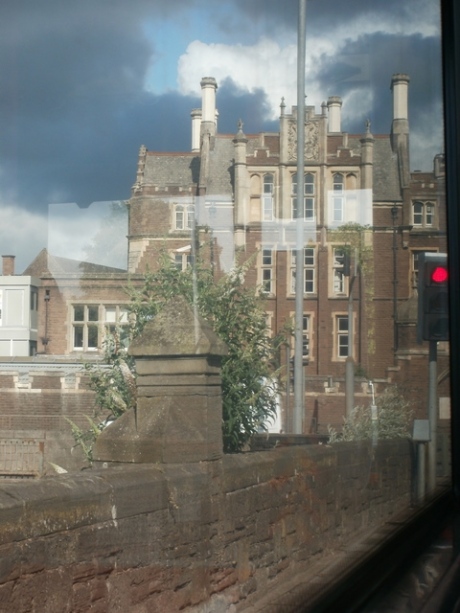 I took this photo from the bus as we entered the town, about halfway across the River Wye.[/caption]
I took this photo from the bus as we entered the town, about halfway across the River Wye.[/caption]I made my way back to the Shire Hall, and spotted a little archway just beside it:
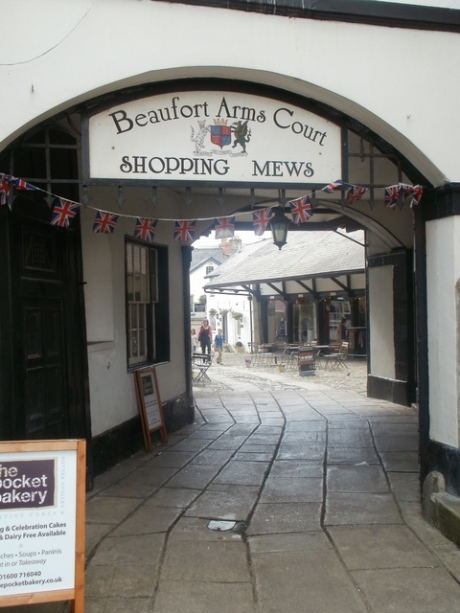
It led me into a cobbled square surrounded by small specialist shops, and I thought for a moment that I was back in Reggie Perrin territory, but updated for the 21st Century: 'Five boutiques, four artisan bakeries, three coffee shops…'
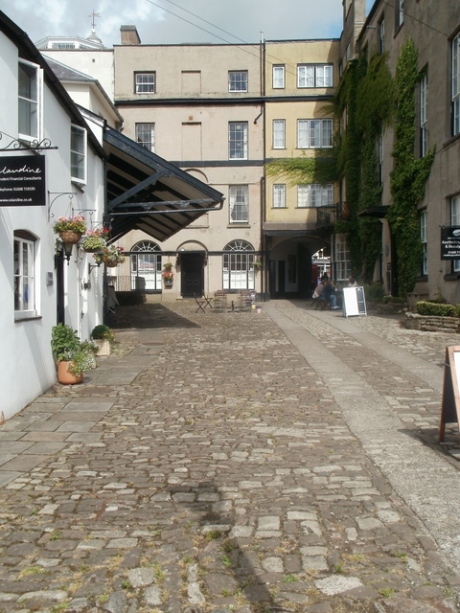
There were some more beautiful sandstone buildings behind this little enclave, so I took a photo before returning to the main square.
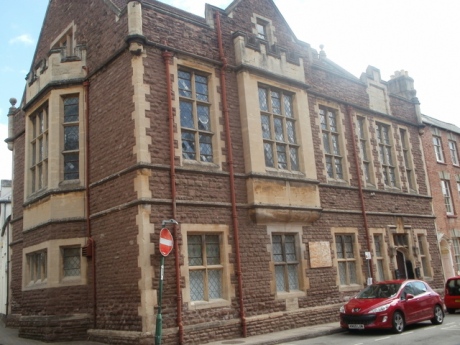
There was a pub here called The Punch House, and it was open by the time I'd completed my journey around the town. I still had time to kill before the bus, so I called in for a glass of Coke.
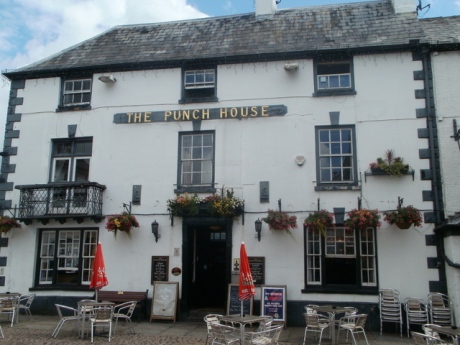
As I'd walked in, I'd had a sinking feeling that it might be a Wetherspoon pub. To my amazement, it was actually part of the S.A. Brain estate – it's very unusual to find one of their pubs this far from Cardiff. (Monmouth isn't Wetherspoon-proof, however – I passed their offering when I was on the way to the bus station.)
While I drank my Coke, I eavesdropped on the conversations going on around me. It sounded as though the weather had put the mockers on the festival the previous evening. Mind you, it turned out that I hadn't missed anything special – the headline act had been an Oasis tribute band. The real thing were bad enough…
I walked back along the main street to the bus station. A few minutes later the Phil Anslow bus arrived, and I bought my Network Rider ticket when I boarded. I found a seat near the middle of the bus and sat back to enjoy the journey.
The drive out to Raglan was a rerun of the outward trip, and we passed farmhouses and cottages set amongst rolling fields. I was trying to concentrate on the scenery, but two teenage girls sitting beside me were engaged in a non-stop US-style Teenspeak 'conversation': 'I was, so, like, Oh. My God., like…' and so forth. They were looking forward to receiving their A Level results in just over a fortnight. The eager young minds…
When we got to Raglan, I decided to have a second attempt at photographing the castle from the bus. In the film Flashback, Dennis Hopper's character offers some good advice to Kiefer Sutherland's, along the lines of 'You can't shoot from a moving vehicle.' He was right – and it applies to cameras as well as firearms. I had Raglan Castle in my viewfinder perfectly as we came off the junction, believe it or not…
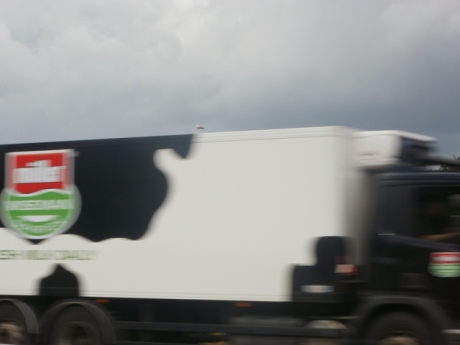
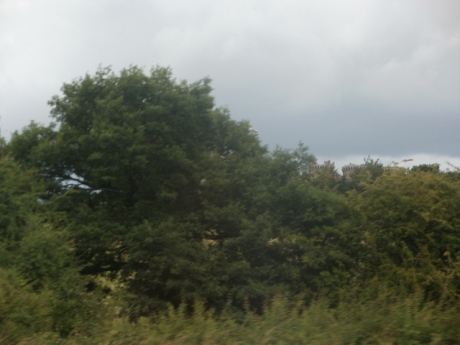
In Raglan itself, we found ourselves at one side of a traffic jam. A lorry was parked in the middle of the village, and nobody else was going anywhere fast. After checking that nobody wanted to get off, the driver turned the bus around and we headed back out to the junction. I didn't even bother trying for a shot of the castle this time; I'd learned my lesson.
We made our way through the narrow country lanes at a fair rate, and I wished (again) that the map had covered the area we were travelling through. I remember that we passed through a village called Great Oak, and I saw a signpost for a place called Kingcoed – a weird hybrid of English and Welsh elements. If you've driven along the A40, and ever found yourself wondering what is on top of the occasional overbridges you encounter, now you know:
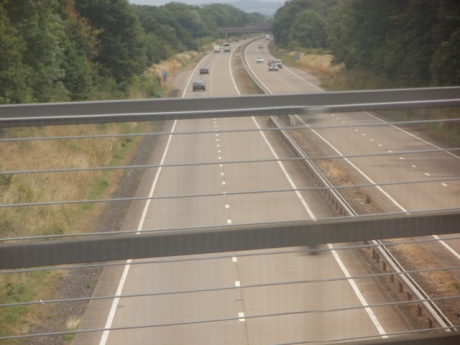
We arrived at Abergavenny and the Merthyr service was already in. I jumped off one bus and straight onto the other, taking a seat near the back. I didn't see a lot of the scenery on the journey to Merthyr, as I dozed off. It was really warm on the bus, and I was so tired that the whole weekend caught up with me. I woke up again when we were travelling through the outskirts of Merthyr. Once again I was able to get off one bus and onto another.
By now, the Forest accent was long-gone, replaced by the expletive-heavy Wenglish dialect I'm used to. I jumped off the bus in Aberdare and made my way straight to the Prince. I'd been Tweeting my progress, so Rhian knew I was on my way home. I hadn't been in there long when she came in. I gave her her postcard and her 'piece of rock', which amused her greatly. She worked the 4.00-8,00 shift, then we walked to the Glosters for a pint. We were both bored to tears of the same old faces and the same tedious conversations in the pub. I showed her some of my photos, before I decided it was time for a bite to eat, a nice hot bath, and an early night.
I've been looking through the public transport websites again this week, and reading various entries about the Forest of Dean in my reference books. I think I'll be spending another couple of days in that part of the country if I can get the money together (and the weather stays fine.) It's close enough to be within an easy morning's travelling, and far enough away for you to forget about home for a while. In spite of the unpredictable weather, the rip-off attraction prices, and the rather laissez-faire attitude to tourist information, it's definitely worthy of a repeat visit.
Comments
Post a Comment